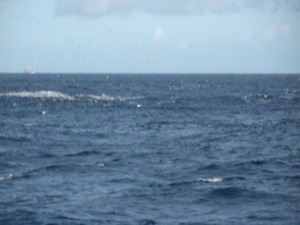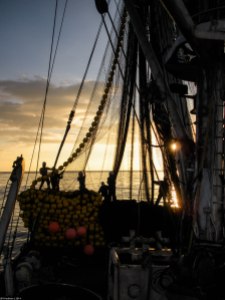melee, fracas, disturbance, riot, ruckus, scuffle, affray,
contest, rumpus. broil, brouhaha, conflict
I took a look at a few of the entries for this weeks Weekly Photo Challenge from the Daily Post (FRAY). Most of the ones I’ve seen so far seemed to flow from the use of the word as wear, erode, unravel, etc.
I already put up a post using the word ‘fray’ like that, but it also seemed like a good word to use to describe some of my experiences on the Pacific Breeze while tuna fishing. Sometimes, it really does feel like you’re ‘rushing into the fray’.
My photos don’t really do it justice. I only had a cheap point & shoot camera with me and most of the action took place a long way from where I was. I hope you can get the gist of the story from the few photos I’ll post here.
When the fish are showing, it can get like the Wild, Wild West out there at sea. There can be flashing schools of tuna as far as the eye can see and dozens of boats from a half a dozen countries all fighting for the chance to set their nets on the biggest schools of the best fish.
You better believe it is a SERIOUS business! It can get REALLY crazy!



It’s a real challenge. The fish are not as dumb as you might think. It’s not really that easy to catch them. They manage to escape before the net is set more times than not. Then we have to wait a couple of hours to get the net back onboard and everything readied before we can try again.
Yes, it is a real riot, the boats are definitely in a contest and sometimes engage in a scuffle. The fish are showing in a disturbance of the surface of the ocean and they broil at the surface. That is how we find them (along with the birds to lead the way).


The way it works with ‘school fish’ is that first we have to spot the school. The lookouts are up in the crows nest and report the sighting to the Fishmaster. He will decide if we are going to go any closer to check out the school.
We can spot the fish on the RADAR by their disturbance of the surface of the water. The large flocks of feeding seabirds also show up on the screen and help lead us to the fish.
Once we get closer, we can use our SONAR to look beneath the surface and get a better idea of what we’re looking at. The Fishmaster can get a lot of information on what kinds of fish are there, how many of them there are, the depth they’re at, etc. Then he will decide if it’s worth it for us to set the net.
If we do, the entire crew springs into action. A couple of guys will jump in the skiff boat. The Radio Officer will assist on the SONAR and RADAR. The engineers will be standing by in the engine room to make sure everything is OK with the power. A couple of guys will get ready to help keep the fish contained from the boat (they throw dye markers and pound on the boat to make noise-both of those the fish will avoid).
When the Fishmaster thinks the time is right, he will yell: “skiff booooooaaaaat……… LET GO!” and the skiff boat will drop off the stern of the boat with the end of the net attached. We will drive around the school of fish dropping the net as fast as we can while the guys throw out the dye markers and pound those hammers. It gets really exciting. 🙂
While we are rushing as fast as we can (not actually all that fast- maybe 10 knots tops), the speed boat and the net boat (and helicopter if the boat has one) will be doing all they can to keep the fish contained inside the area where we are setting the net around them. We need to get the net run around the whole school and then haul in the bottom of the net to close it before the fish get wise to the game and swim underneath it.
It’s such a great feeling. It gets really intense. Your adrenaline starts pumping, your concentration goes up. The challenge, the anticipation, the not-knowing, the feeling that you’re doing everything you can but it might all be for nothing. It can hook you along with the fish you’re trying to catch. I do love it! 🙂
Then it takes a couple of hours to haul in the net. We never really know what we’ve caught in there until we pull it up close enough to the boat to start ‘brailing’ it out. Usually, if we’re lucky it’s full of nice big amberjack tuna. And yes, they broil in the net! It’s always a thrill to count over 10 scoops (each one holds between 3-5 tons of fish). Lots of times it’s empty, the fish got away.
This is what a net full looks like when we’re brailing them out. If I remember right, this was a pretty good catch. 🙂

Just to clarify, the skiff boat is the one in the last photo holding open the net so we can brail it out. The speed boat is the little yellow one in the 3rd and 5th photo. The net boat is the one towards the bottom of the 5th photo, we use it to help hold the net open which makes it easier to haul it in.













